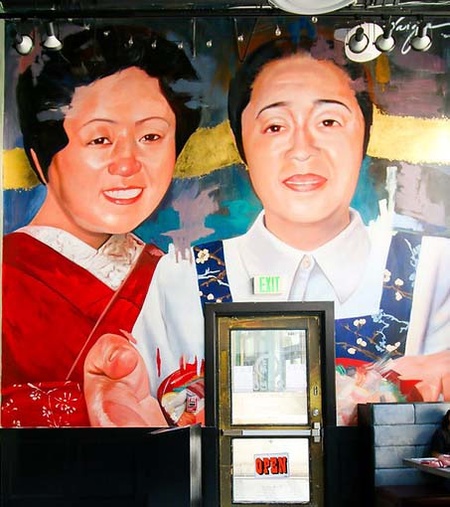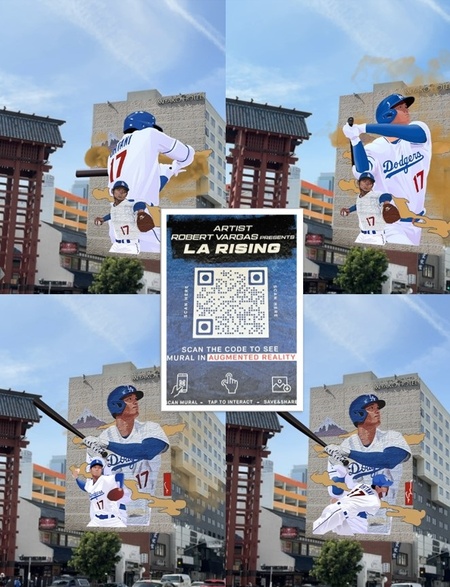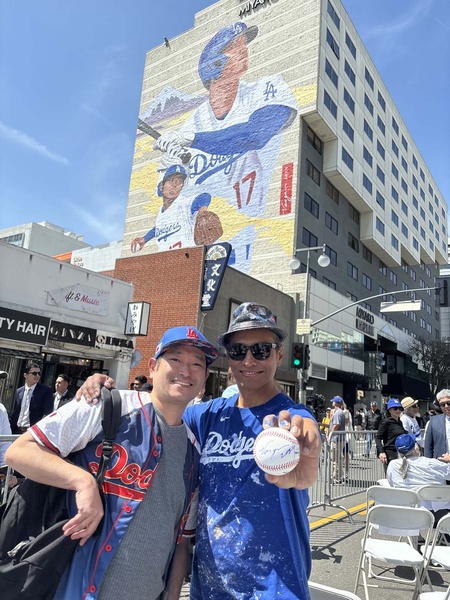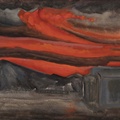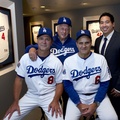On March 27, 2024, Robert Vargas’ newest mural, “LA Rising,” was unveiled in the heart of Los Angeles’ Little Tokyo district to a crowd of upwards of 200 people. Located on the east-facing side of the Miyako Hotel, the mural spans 150 feet in height and 60 feet in length, and features lifelike portraits of the Los Angeles Dodgers’, Shohei Ohtani, as both a hitter and pitcher.
The mural itself had special meaning to artist, Robert Vargas, due to its proximity to his hometown of Boyle Heights, where he was born and raised. Vargas recalls that “from the front porch [of his childhood house] he could see the Downtown Los Angeles skyline, where he would dream big and [eventually] paint big, and that from his back porch he could see Dodger Stadium.”
Work on the “LA Rising” mural began on March 8, 2024 and was entirely done freehand without the use of any projections. The mural would take Vargas a total of 13 days (and occasionally nights) to complete, and required him to board a suspended scaffolding system to reach its massive heights. On March 27, 2024, an hour prior to the scheduled public unveiling event, Vargas could still be seen adding the finishing touches to his mural.
The scheduled public unveiling event, was hosted by actress Tamlyn Tomita, and featured various community leaders and representatives from Los Angeles City’s government, who presented Vargas with plaques of recognition for his work. Additionally, attendees of the event were treated to a live Taiko performance and able to view a lineup of classic low-rider cars. The fusion of both the Japanese and Hispanic cultures, would ultimately coincide with Vargas’ vision and goal for the mural to, “[create] unity and bridge cultures and people together.”
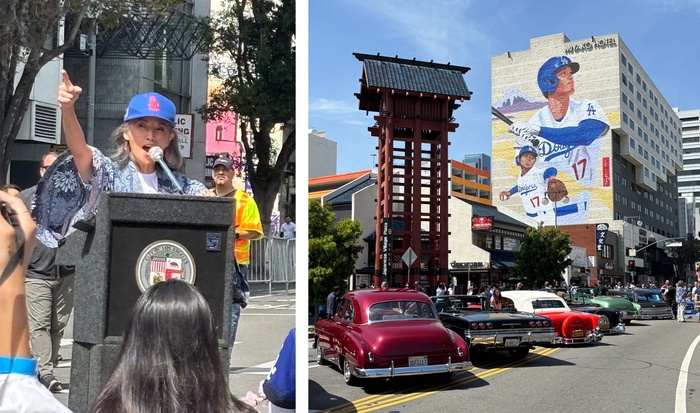
From a historic perspective, the Little Tokyo and Boyle Heights neighborhoods have long been culturally intertwined with each other. “Between 1869 and 1910, Los Angeles rose to prominence as a destination for Japanese immigrants, becoming home to the largest Issei population in the United States by 1910.”1
Many of the Japanese immigrants would settle in downtown Los Angeles, in an area referred to as Little Berlin, due to the prevalence of German merchants. By 1905, Little Berlin, would become known as Sho Tokyo or Little Tokyo, due to increase of Japanese businesses and residences. Eventually, as the Japanese population continued to grow, the Japanese immigrants would settle in more rural neighborhoods, such as Boyle Heights, where they could raise their families.
In an interview, Vargas would acknowledge the influence of the Japanese culture in his hometown of Boyle Heights, and how over time the “Japanese and Latin cultures have become intertwined.” He would also mention that he is a frequent visitor of Little Tokyo, as he estimates he visits Little Tokyo businesses “3-4 times a week.” He hopes that his mural will “help contribute to Little Tokyo’s commerce.”
Prior to painting the “LA Rising” mural, Vargas would contribute towards one of Little Tokyo’s former legacy businesses, Suehiro Café, by painting a mural at their new location in Downtown Los Angeles. The Suehiro Café mural titled, “Shimai” (Sisters) features the portraits of the café’s founders, Junko Suzuki and her sister, Yuriko Morita Regaert, serving one of the many flavorful dishes the café would serve its customers since its opening in 1972.

The “LA Rising” mural features portraits of Los Angeles Dodgers’, Shohei Ohtani, as both a hitter and pitcher against a Japanese inspired background featuring Mount Fuji. The addition of Mount Fuji in the background has special meaning to Vargas, as he would see the mountain while riding Japan’s Shinkansen (bullet train), enroute to Kyoto’s Tenryu-ji Temple, where he was invited to draw a portrait of the temple’s chief priest, Noriaki Kunitomi.
In addition, the “LA Rising” mural features an augmented reality aspect, that was created in collaboration with the AR firm, and allows viewers to scan a QR code and watch the mural animate. Specifically, when viewers scan the QR code and point their phone towards the mural, they will be able to see the larger-than-life Shohei Ohtani swing the bat and pitch a strike towards Dodger Stadium, while former Dodger broadcaster, Vin Scully, announces that “it’s time for Dodger Baseball.”
The mural itself is a beautiful addition to the Little Tokyo district that truly does “bridge cultures and people together.” In addition to bringing “unity,” Vargas sincerely hopes that his mural will allow the Little Tokyo community to “thrive” and “that the people who come who appreciate art, will also appreciate the Japanese culture and support the local businesses.”
Note:
1. Staff. “Los Angeles Citywide Historic Statement Context: Japanese Americans in Los Angeles, 1869-1910.” Los Angeles Historic Resources Survey. August 2018. Accessed April 1, 2024.
© 2024 Kristopher Kato




